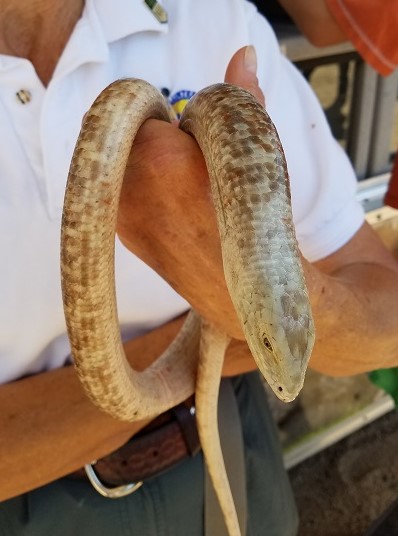“Don’t tell anyone,” a man said with a smirk as he sidled toward me, “but you’re holding a snake!”
“No, I’m not,” I replied.
The man turned serious and scowled. “You sure are!”
“No,” I said again. “This is a lizard.”
Volunteering
Chuck and I were volunteering with the Phoenix Herpetological Society (PHS) at the Ben Avery Outdoor Expo north of Phoenix for a couple days. When I noticed that the legless lizards were hiding under their substrate in their cage, I asked if we could take one out for the public to see since there seemed to be a lot of interest from passersby.
“Don’t drop it,” the staff member told me as he handed me the nearly two-foot lizard. I recalled that he had earlier told me that, like many lizards, the legless lizards can drop their tails if threatened. However, tails on these lizards (also called glass lizards) shatter like glass when they fall off. I certainly did not want that to happen to an animal in my custody!

Learning
During our two days with PHS, we learned much about different reptiles, some of which we’d never before encountered. But the legless lizards drew a lot of interest from the public, and I must admit they fascinated me as well. We already knew a couple differences between snakes and lizards: lizards have eyelids while snakes’ eyes are always open, and lizards have ear openings, while snakes are virtually deaf.
They certainly looked like snakes with their long, sleek image, but much of the length is actually the tail of the lizard. We encountered some questions about these animals that we had no answer for and later researched.
Research
“What’s the line down their sides for?” several visitors asked. We later learned that the “lateral groove” along their sides that we thought looked like the lateral line on a fish for sensory purposes helps the lizard expand their body while eating.
“The head looks different from a snake,” several people commented. Besides ear openings and eyelids, we discovered that, like other lizards, legless lizards cannot distend their jaws to accommodate food items larger than their heads. Snakes can expand their mouths vertically and horizontally with stretchy ligaments to swallow something comparable to a human swallowing a whole watermelon.
More Research
Further research indicated that these lizards flick a notched tongue rather than a forked tongue as found in snakes and monitor lizards. Also, they lack the broad belly scales of a snake. Neither of these characteristics were obvious to me at the time, but if I encounter these animals again, I will examine them more closely.
The man who originally thought I was holding a snake listened carefully as I described some of the differences between snakes and lizards and explained why this animal was not a snake even though its appearance was similar. As he inspected the lizard, he muttered, “Isn’t that something!” With his interest aroused, perhaps when he returned home that evening he, too, did more research on these creatures.
Broaden Horizons
We enjoyed learning about and handling new reptiles and working with the knowledgeable PHS staff. It’s important, we feel, to continue learning and to interact with others who can broaden our horizons!


Boy, was that an interesting artucle about something I had never encountered. So glad you added to my education as well.
Thanks, Jeanne! We never want to get to the point that we stop learning!
What an interesting article. Thanks for all the NEW information.
Glad you enjoyed reading! We enjoyed learning ourselves!
Betty,I enjoyed reading your article. You and Chuck are always fnding ways to share your knowledge and enthusiasm for learning about animals. I admire your commitment. Enjoy Spring!
Thank you, Sara! It’s always a pleasure to learn something new and then have great comments from good friends like you two!
Always learning from your great articles. Thanks.
Thanks, again for those great comments….we’ll see you in JH reeel soon!
Really cool article! I am glad you had a good time. 🙂
Thanks for the great comments, Joe! We really appreciated your help on those two days!